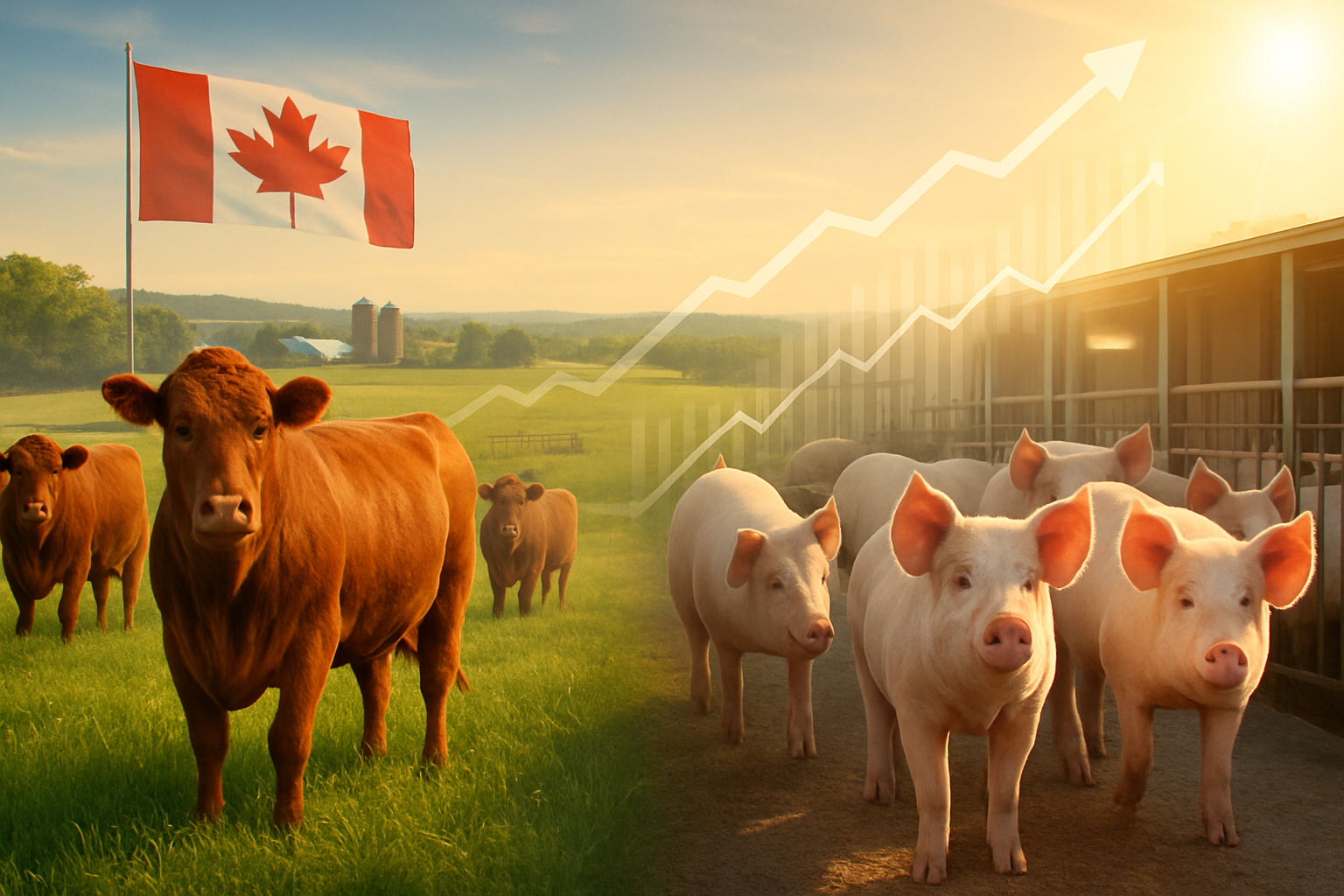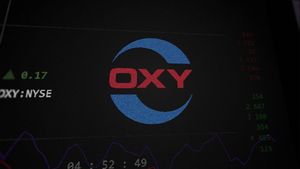
Canada's agricultural landscape is witnessing a robust resurgence in its livestock sector, with both cattle and hog industries exhibiting strong positive trends that are significantly bolstering the nation's farm economic outlook. As of October 2025, producers are enjoying a period of enhanced profitability and expanding production, injecting crucial vitality into rural economies and contributing substantially to overall agricultural growth. This optimistic scenario, however, unfolds against a backdrop of potential trade headwinds and evolving market dynamics that warrant close monitoring.
The current buoyancy in the livestock market is largely fueled by a confluence of factors, including constrained supply, resilient consumer demand, and strategic industry adaptations. While the cattle sector benefits from record-high prices driven by a smaller North American herd, the hog industry is seeing increased production and improved margins, partly due to favorable feed costs and significant corporate restructuring. These developments are not only providing immediate financial relief to producers but are also setting the stage for potential long-term stability and growth within these vital segments of Canadian agriculture.
Unpacking the Surge: Record Prices, Strategic Shifts, and Market Reactions
The cattle sector stands out with unprecedented price levels, offering a much-needed boost to producer profitability. As of late September 2025, fed steer and heifer prices have reached approximately $312/cwt live, with feeder steer and heifer prices also significantly elevated. The calf market, in particular, has been described as "on fire," with some lightweight feeder steers fetching all-time highs of $540/cwt in July. These remarkable prices are a direct consequence of a historically small North American cattle herd and sustained robust consumer demand, both domestically and internationally, particularly from Asian markets. This improved financial environment is cautiously encouraging some producers to retain more replacement heifers, a critical, albeit slow, step towards herd rebuilding, as the overall Canadian cattle herd remains at a three-decade low as of January 1, 2025.
In parallel, the Canadian hog sector is charting its own course of positive momentum. Pork production is projected to increase by 1% in 2025, supported by higher slaughter numbers and heavier carcass weights. This growth is underpinned by strong sow productivity and enhanced slaughter capacity, especially in Western Canada, which is offsetting declines in Eastern regions. Hog futures prices are strong, and anticipated lower feed costs for corn and barley are contributing to some of the best margins farrow-to-finish operations have seen in years. A weaker Canadian dollar further amplifies farm receipts for exporters, solidifying the sector's financial health.
A pivotal event for the hog industry occurred on October 2, 2025, with Maple Leaf Foods (TSX: MFI) completing the spin-off of its pork operations into a new, independent publicly traded company, Canada Packers Inc. (TSX: CPK). This strategic move allows Canada Packers to specialize in pork production, from farm to processing, boasting substantial capacity to process nearly five million pigs annually and diversified revenue streams. This restructuring is anticipated to enhance efficiency, competitiveness, and long-term value within the Canadian pork industry, marking a significant milestone in its evolution. Initial market reactions have been largely positive, with producers experiencing strong profitability and renewed confidence in the sector's trajectory, despite the ongoing challenge of a relatively small overall cattle herd and the need for continued vigilance regarding export markets.
Corporate Fortunes: Winners and Losers in the Livestock Boom
The robust performance of Canada's cattle and hog sectors has direct implications for a range of publicly traded companies, creating both significant opportunities and potential challenges. Companies across the agricultural supply chain, from input suppliers to meat processors, are feeling the ripple effects of elevated livestock prices, improved producer profitability, and strategic industry shifts.
Agricultural input and equipment suppliers stand to benefit from the revitalized farm economy. Nutrien (TSX: NTR), a global leader in crop inputs and services, is well-positioned as improved farmer profitability often translates into increased investment in fertilizers, seeds, and crop protection products necessary for feed production. Similarly, AG Growth International (TSX: AFN), which designs and manufactures equipment for grain handling, storage, and processing, is likely to see heightened demand for its solutions as livestock producers and feed operations seek to optimize efficiency amidst strong market conditions. While these companies have diversified portfolios, the buoyancy in the livestock sector provides a strong tailwind for their Canadian operations.
The meat processing segment is experiencing a more nuanced impact. The newly independent Canada Packers Inc. (TSX: CPK), spun off from Maple Leaf Foods (TSX: MFI) on October 2, 2025, is a direct beneficiary of the strong hog market. With elevated hog prices and significantly lower feed costs expanding profit margins, Canada Packers is poised for increased revenue and improved profitability from its specialized pork production and processing operations. Its focused strategy post-spin-off is expected to allow it to capitalize more effectively on these favorable market conditions and strong export demand. Conversely, Maple Leaf Foods (TSX: MFI), while still holding a 16% stake in Canada Packers and maintaining a supply agreement, has largely de-risked its direct exposure to the volatile hog processing business, now focusing more on its prepared foods and poultry segments. Its future performance will be driven more by these diversified operations, though it will still indirectly benefit from Canada Packers' success.
However, the positive outlook is tempered by considerable risks, particularly the looming threat of U.S. trade barriers. The potential imposition of tariffs on Canadian pork products could severely impact Canada Packers Inc.'s profitability, given its reliance on international sales, potentially eroding the hard-won margins. For the cattle sector, similar trade disruptions could lead to a significant decline in Canadian cattle prices, affecting profitability for producers and, by extension, the entire entire supply chain. Companies like Premium Brands Holdings Corporation (TSX: PBH), a diversified food company with exposure to the meat sector, may see benefits from robust meat demand but could also face pressure on margins from higher raw material costs if not fully passed on to consumers. The ability of these companies to navigate these geopolitical uncertainties will be critical to sustaining their current positive momentum.
Wider Significance: Navigating Trade Winds and Industry Evolution
The current strength in Canada's livestock sector is a critical component of the broader agricultural narrative, highlighting resilience and adaptation in the face of global economic shifts. The slow but deliberate process of herd rebuilding in the cattle industry, driven by improved profitability, signifies a long-term commitment to stability and growth after years of contraction. This trend is crucial for ensuring a sustainable domestic beef supply and maintaining Canada's position in competitive international markets. For the hog sector, increased production and strategic restructuring, such as the Canada Packers Inc. spin-off, underscore an industry striving for greater efficiency and specialization to maximize value from strong global demand.
However, this positive momentum is overshadowed by significant external pressures, primarily the potential for disruptive U.S. trade policies. The highly integrated North American livestock market means that any imposition of U.S. tariffs or voluntary Country of Origin Labeling (vCOOL) could have immediate and severe ripple effects. Such measures could substantially depress Canadian livestock prices, widen price bases, and force Canadian exporters to either absorb losses or aggressively seek new markets, potentially straining existing trade relationships and infrastructure. This vulnerability highlights the ongoing need for robust trade advocacy and diversification of export markets.
Historically, the livestock sector has often been a bellwether for agricultural health, with periods of high commodity prices typically spurring investment and expansion. However, the current scenario is unique due to the confluence of a historically small cattle herd, strong global demand, and the ever-present geopolitical risks. Unlike previous cycles where herd expansion might have been more rapid, the current rebuilding phase is slower, suggesting a more cautious and potentially more sustainable growth trajectory. The industry's ability to manage feed cost volatility, processing capacity constraints (especially for hogs reliant on live exports to the U.S.), and evolving consumer preferences for protein sources will be key determinants of its long-term success.
What Comes Next: Pathways to Sustained Growth and Emerging Challenges
Looking ahead, the Canadian livestock sector faces a dynamic landscape with both promising opportunities and considerable challenges. In the short term, the sustained high prices for cattle and strong margins for hogs are expected to continue supporting producer profitability into early 2026, assuming feed costs remain manageable and export demand holds firm. For the cattle sector, the focus will remain on the gradual rebuilding of the national herd, a process that is inherently slow but vital for long-term supply stability. Success in this area will depend on continued favorable economic conditions that encourage heifer retention and investment in breeding stock.
For the hog industry, the strategic initiatives, such as the specialization offered by Canada Packers Inc. (TSX: CPK), aim to enhance competitiveness and efficiency. Continued investment in processing capacity, particularly in Western Canada, will be crucial to reduce reliance on live hog exports to the U.S. and mitigate risks associated with potential trade disruptions. Exploring and expanding into new international markets beyond traditional partners will also be a key strategic pivot to diversify revenue streams and build resilience against protectionist trade measures.
In the long term, the sector must adapt to broader industry trends, including evolving consumer preferences for sustainably produced and ethically sourced meat, and the increasing digitalization of farming practices. Climate change and its impact on feed crop production and animal health also present ongoing challenges that require proactive management and innovation. Market opportunities may emerge from value-added processing and niche product development, catering to premium markets that are willing to pay for specific attributes. However, the overarching challenge remains the navigation of international trade relations, particularly with the U.S., as any significant policy shift could swiftly alter the economic outlook for Canadian livestock producers and processors.
Comprehensive Wrap-up: A Resilient Sector with Critical Crossroads Ahead
In summary, Canada's livestock sector is currently a leading light in the nation's farm economic outlook, characterized by robust prices and improved profitability across both cattle and hog industries. This positive momentum, driven by tight supplies, strong demand, and strategic corporate restructuring, is providing a much-needed boost to agricultural growth and farmer incomes. The spin-off of Canada Packers Inc. (TSX: CPK) from Maple Leaf Foods (TSX: MFI) marks a significant step towards specialized and efficient pork production, while the cattle sector embarks on a cautious but vital herd rebuilding phase.
Moving forward, the market will largely be shaped by two critical factors: the industry's ability to continue its slow but steady growth in herd sizes and production efficiency, and its success in navigating the complex landscape of international trade. Investors should closely watch developments regarding potential U.S. trade barriers, as these represent the most significant near-term threat to the sector's profitability and stability. Additionally, monitoring global demand trends, feed input costs, and the pace of innovation in sustainable livestock practices will provide crucial insights into the long-term trajectory of publicly traded companies like Nutrien (TSX: NTR), AG Growth International (TSX: AFN), Canada Packers Inc. (TSX: CPK), and Premium Brands Holdings Corporation (TSX: PBH). While the current outlook is undeniably positive, the sector stands at a crossroads, where strategic foresight and adaptability will be paramount in sustaining its upward momentum and ensuring lasting impact on the Canadian economy.
This content is intended for informational purposes only and is not financial advice.






